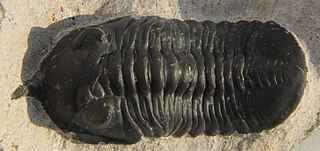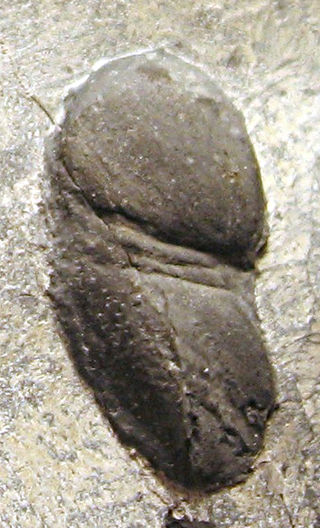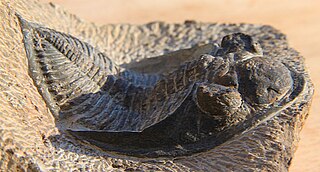
Trilobites are extinct marine arthropods that form the class Trilobita. Trilobites form one of the earliest known groups of arthropods. The first appearance of trilobites in the fossil record defines the base of the Atdabanian stage of the Early Cambrian period and they flourished throughout the lower Paleozoic before slipping into a long decline, when, during the Devonian, all trilobite orders except the Proetida died out. The last trilobites disappeared in the mass extinction at the end of the Permian about 251.9 million years ago. Trilobites were among the most successful of all early animals, existing in oceans for almost 270 million years, with over 22,000 species having been described.

Phacopidae is a family of phacopid trilobites that ranges from the Lower Ordovician to the Upper Devonian, with representatives in all paleocontinents.

Phacops is a genus of trilobites in the order Phacopida, family Phacopidae, that lived in Europe, northwestern Africa, North and South America and China from the Late Ordovician until the very end of the Devonian, with a broader time range described from the Late Ordovician. It was a rounded animal, with a globose head and large eyes, and probably fed on detritus. Phacops is often found rolled up ("volvation"), a biological defense mechanism that is widespread among smaller trilobites but further perfected in this genus.

Dalmanites is a genus of trilobite in the order Phacopida. They lived from the Late Ordovician to Middle Devonian.

Paradoxides is a genus of large to very large trilobite found throughout the world during the Middle Cambrian period. One record-breaking specimen of Paradoxides davidis, described by John William Salter in 1863, is 37 cm (15 in). The cephalon was semicircular with free cheeks ending in long, narrow, recurved spines. Eyes were crescent shaped providing an almost 360° view, but only in the horizontal plane. Its elongate thorax was composed of 19–21 segments and adorned with longish, recurved pleural spines. Its pygidium was comparatively small. Paradoxides is a characteristic Middle-Cambrian trilobite of the 'Atlantic' (Avalonian) fauna. Avalonian rocks were deposited near a small continent called Avalonia in the Paleozoic Iapetus Ocean. Avalonian beds are now in a narrow strip along the East Coast of North America, and in Europe.

Dikelocephalus is a genus of very large trilobites of up to 50 cm (20 in) long, that lived during the last 3 million years of the Cambrian (Sunwaptan). Their fossils are commonly found as disarticulated sclerites, in the upper Mississippi Valley and in Canada (Alberta). The exoskeleton is rounded anteriorly, with the thorax and sides of the tailshield slightly tapering to about 2⁄3× of the width across the base of the spines at the back of the headshield. At the side corners of the pygidium there may be triangular or hooked spines, pointing backwards, while between the spines the posterior margin is at a 30-75° angle with the lateral margin, gently convex or nearly straight. If pygidial spines are lacking, the margin is gradually rounded. The thorax has 12 segments.

Fallotaspis is a genus of redlichiid trilobites found in Early Cambrian-aged strata of the United States and Morocco.

Morocconites malladoides is an average size trilobite, which lived during the Devonian period, in what is now southern Morocco. This species is assumed to be a close relative of Acastoides. The most conspicuous feature is the very long upcurved frontal medial spine, a bit like an avocet bill. It is the only known species in this genus.

Tariccoia is a genus of nektaspid arthropods belonging to the family Liwiidae, known from fossils found in Ordovician strata in Sardinia and Morocco. It is between 2.5 centimetres (0.98 in) and 6 centimetres (2.4 in) long. It has a headshield wider than the tailshield (pygidium), and in between them three thoracic body segments (somites).

Biceratops is an extinct genus of olenelloid redlichiid trilobites, of average size, with the largest specimen 8 centimetres or 3.1 inches long, not including the huge pleural spines of the 3rd segment of the thorax. It lived during the Toyonian stage, in what is today the South-Western United States. Biceratops can easily be distinguished from other members of Biceratopsidae by the absence of genal spines, in combination with effaced features of the raised axial area of the head shield, that is bordering the two horn-like projections that carry the eyes. Biceratops nevadensis is the only known species in this genus.

Odontochile is a genus of trilobites in the order Phacopida, family Dalmanitidae.

Galbagnostus is an extinct genus of agnostid trilobite. It lived during the Lower and Middle Ordovician.

Geragnostus is a genus of very small agnostid trilobites whose fossils are found Ordovician-aged marine strata from Eurasia, North America and Argentina.

Cyclopyge is a genus of small to average size trilobites that lived during the Ordovician. Like all members of the family Cyclopigidae, it has very large convex eyes, that cover most of the free cheeks, and in some species touch each other. The eyes almost touch the large glabella. The occipital ring has merged with the rest of the glabella. The glabella does not extend into a frontal thorn. The cephalon lacks genal spines. The 6 thorax segments have short pleurae. The pygidium is rather large, and often rather effaced. These are features that also occur in other Cyclopygidae, and are indications of a pelagic lifestyle.

Cyclopygidae is a family of asaphid trilobites from the Ordovician. Cyclopygids had an extratropical distribution, and there is evidence that they lived in darker parts of the water column. Cyclopygids are characterized by enlarged eyes, with a wide angle of view, both horizontal and vertical, reminiscent of the eyes of dragonflies. These typically touch the glabella directly on the side. Cyclopygids all lack genal spines, but Symphysops carries a forward directed frontal spine on the glabella. It is presumed that at least the members of the genus Pricyclopyge swam upside down and had bioluminescent organs on the third thorax segment. Cyclopygids had between 7 and 5 thorax segments, a wide and stout axis, and short side lobes.

Pricyclopyge is a genus of trilobites assigned to the family Cyclopygidae that occurs throughout the Ordovician. Pricyclopyge had an extratropical distribution, and there is evidence that it lived in darker parts of the water column. Pricyclopyge has huge eyes, an inverted pear-shaped glabella, six thorax segments, with on the 3rd two small discs. Pricyclopyge is known from what are today China, the Czech Republic, France, and the United Kingdom.

Pliomera is a genus of trilobites that lived during the Middle Ordovician on the paleocontinent Baltica, now Norway, Sweden, Estonia and the Russian Federation, and in Argentina. It can be recognized for its pentagonal glabella widest between the frontal corners, with an inverted V-shaped occipital ring. In front of the occipital furrow that crosses the entire glabella, two pairs of dead-ending furrows create three side lobes left and right. The front of the glabella also has three dead-ending furrows, a very short one on the midline and left and right a longer one, directed inward and slightly backward. The eyes are small and are not connected to the glabella by an eye ridge. The thorax and pygidium are very regularly divided into up to 23 rather narrow segments, without a furrow within each of the pleurae. The pleurae are clearly wider than the axis. The pygidium ends in downward pointing toothlike spines.

Psychopyge is a genus of trilobite, that lived during the upper Emsian and has been found in Germany and Morocco. It is characterized by the swordlike extension from the front of the head.

Placoparia is a genus of trilobites of average size that lived during the late Lower to the early Upper Ordovician on the paleocontinents Gondwana, Avalonia and Laurentia, now the Czech Republic, France, Germany, Morocco, Portugal, Spain and Wales. Its headshield is semi-circular to rectangular with rounded frontal corners. It lacks eyes, but eye ridges are present. The fact that the facial sutures are opisthoparian is an exception in the otherwise proparian Cheirurina. The thorax has 11 or 12 segments, with the axis slightly wider than the ribs to its sides. The tips of the pleurae are free, which resembles an old-fashion central heating radiator. The axis in the small tailshield consists of four rings and a minute endpiece. The four pleurae end in spatulate spines that fit to corresponding indentations in the cephalon.

Telephinidae is a family of pelagic trilobites with large wide-angle eyes, occupying most of the free cheeks, downward directed facial spines and 9-10 thorax segments. The family is known during the entire Ordovician and occurred in deep water around the globe.





















